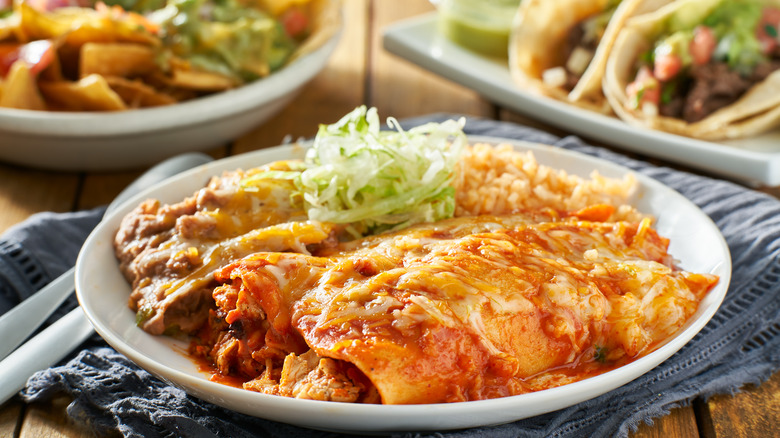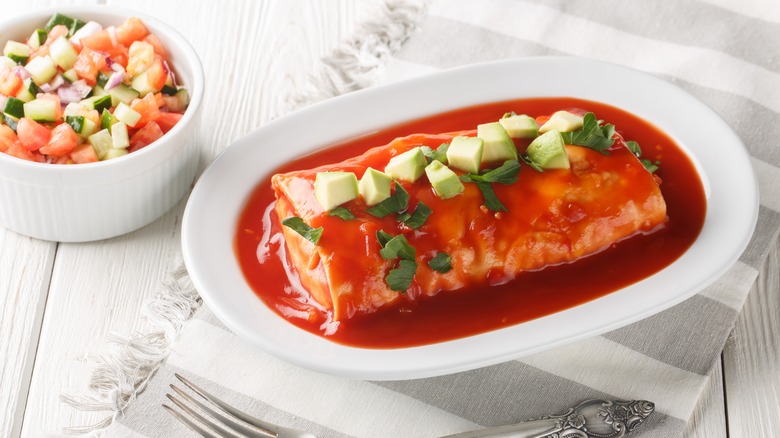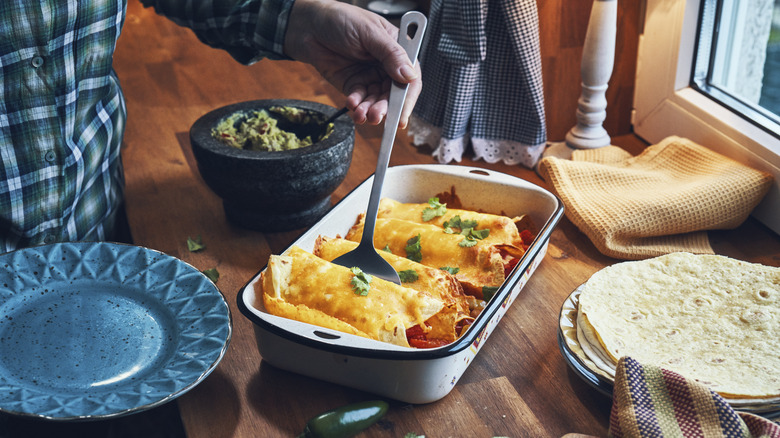What Makes An Enchilada Different From A Wet Burrito?
Mexican food is extremely diverse, but there are a handful of dishes that American diners gravitate towards, including tacos, guacamole, quesadillas, fajitas, and tamales. Oh yeah, and we can't forget enchiladas and wet burritos. These filled, usually saucy tortilla-based creations may seem similar but are distinct in terms of preparation, ingredients, and history. Understanding their differences will ensure you order the right thing the next time you visit your local Mexican restaurant.
The enchilada is far older than the wet burrito (and the regular burrito, for that matter), dating back to the height of the Aztec culture, where they were known as chīllapīzzali, or "chili flutes." Over centuries, they've transformed from simple tortillas dipped in chili paste and filled, to the Tex-Mex enchiladas we know today — stuffed, rolled corn tortillas doused in a spicy chili sauce and plenty of melty cheese like Monterey jack (which has its own interesting roots).
Wet burritos (also known as smothered burritos or enchilada-style burritos — hence the potential confusion between the two) didn't come from Mexico, or even domestic Mexican food meccas like Colorado, California, or Texas. In point of fact, we have the Beltline Bar in Grand Rapids Michigan to thank; according to legend, in 1966 the owner created the dish as a way to use up oversized tortillas.
Wet burritos and enchiladas are prepared differently
Although a wet burrito may look like an oversized enchilada, let's peel back the tortilla to see how each is made. Enchiladas are typically made with corn tortillas, which hold up better when in contact with sauce over a longer period of time, as well as added texture and a sweet, grainy flavor. The fillings can vary but often highlight one simple ingredient, like cheese, beans, beef, chicken, or vegetables. After rolling up the fillings in a corn tortilla, the enchiladas are generously coated in sauce and sprinkled with shredded cheese before being baked.
Wet burritos are less about simplicity and more about abundance. Burrito components, including rice, beans, meat, cheese, and sometimes vegetables are prepared separately, layered in a large flour tortilla, and rolled. This burrito is not unlike the numerous excellent burritos you'd find in California and elsewhere. The next step is what makes a wet burrito stand out — the sauce is ladled on top, followed by cheese, which is usually broiled briefly to achieve a melty, toasted exterior.
Enchiladas and wet burritos are unique eating experiences
The sauces, fillings, rolling technique, cooking time, and serving method all affect the flavor of burritos and enchiladas. Although you'll probably be served them on an individual plate at restaurants, eating enchiladas from a big baking dish at home is a more communal experience. The longer cooking time allows the sauce to soak into the tortilla and deepen the flavor of the dish too. The smaller roll size of an enchilada compared to a burrito also means that you'll get more tortillas and sauce with less filling, which can be less of a gut punch than a hefty wet burrito.
Because of their unwieldiness, wet burritos are served solo. Although they're not baked, the sauce from wet burritos also seeps into the tortilla to make each bite mouth-watering. However, since the tortilla is usually made from flour, it doesn't hold up as well as leftovers as enchiladas might. But, whether you choose a wet burrito or enchilada, you can't go wrong.


